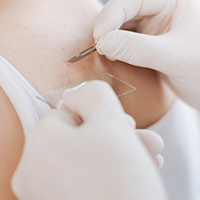
Sweating is a normal and essential bodily process that helps us regulate our body temperature but when is it too much or too little?
Everybody sweats and for most people, the amount of sweating can differ depending on levels of physical activity, room temperature and types of clothing.
Managing sweat
Managing sweating can simply require a few lifestyle adjustments to make yourself more comfortable such as wearing layers of light clothing so you can remove them as you warm up, wearing loose fitting or moisture-wicking fabrics when exercising or out on a hot day and removing foods from your diet that increase sweating.
Sweating can also produce odour which can be managed by using antiperspirant or deodorant, washing dried sweat off after exercise or being out in the heat, and changing out of sweaty clothes to reduce the risk of bacterial or yeast infections.
Sweating too much or too little
Sweating either too much or too little can be a sign of a medical problem. If it comes with other symptoms like chest pain, dizziness, shortness of breath or continued sweating for an extended period of time without cause or if you feel you sweat more than normal or don’t sweat at all, it is time to see your General Practitioner (GP).
Excessive sweating without chest pain, dizziness or shortness of breath can be a sign of hyperhidrosis. If this is the case, your GP may refer you to a dermatologist who is a specialist in skin, hair and nail conditions.
Dermatologist and Fellow of the Australasian College of Dermatologists Dr Adrian Lim fills us in on hyperhidrosis and how to manage it.

Let’s talk hyperhidrosis
Hyperhidrosis is excessive or uncontrollable sweating in certain parts of the body. People with hyperhidrosis excessively sweat for no apparent reason, even when they are not hot or exercising. Around 3 in 100 Australians are affected by excessive sweating which can be an embarrassing and debilitating condition that impacts on the quality of life of those who experience it by preventing normal daily activities due to embarrassment.
It is not known what causes hyperhidrosis, and often the trigger is unknown. This can be the reason why the condition is so debilitating, as people can’t control when or why the sweating occurs.

There are two types of excessive sweating. Sweating that affects certain areas of the body, for example the underarms, the hands or feet, or the face is called focal hyperhidrosis. Excessive sweating that affects the entire body, usually due to an underlying medical condition is known as generalised hyperhidrosis. A dermatologist is trained to identify the type of hyperhidrosis you may have and any underlying medical condition that may be causing it.
There are a range of treatments for hyperhidrosis that your dermatologist can advise on, including special creams and deodorants to help reduce the sweating or using botox to block the sweat glands.
Don’t suffer in silence, seek professional help
If you are affected by excessive sweating, or alternatively lack of sweating, and it is causing you embarrassment, stress or anxiety, it is important that you seek help from a medical professional. Don’t suffer in silence, see your GP who may refer you to a dermatologist who can provide various treatment options.
You can prepare for your medical appointment by answering a few questions:
- Has anyone in your immediate family ever had similar symptoms?
- Does your sweating stop when you’re asleep?
- What medications and supplements do you take regularly?
- Have your symptoms caused you to avoid social situations or activities?
To find a dermatologist in your area, you can visit the ‘Find a Derm’ tool on our website.
Dr Adrian Lim is a dermatologist and Fellow of the Australasian College of Dermatologists

